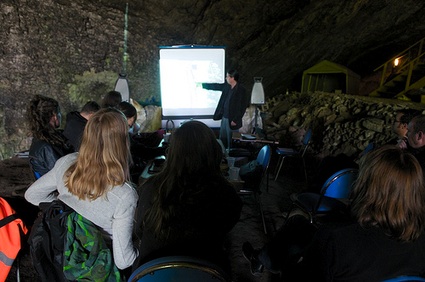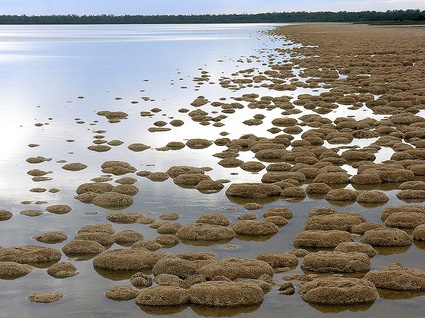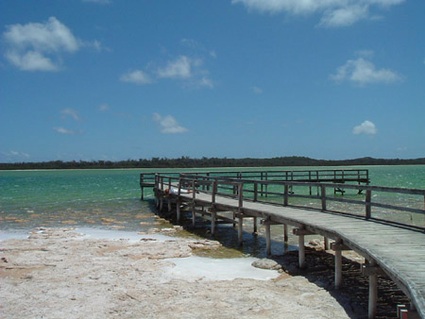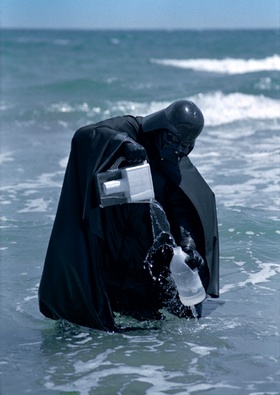Oron Catts, Director of SymbioticA, Centre of Excellence in Biological Arts at The University of Western Australia, contributed to the Biorama 2 discussion with a presentation of Adaptation, the project he and his team are currently working on. Adaptation is radically different from what you would expect. No victimless leather jacket, no banquet of frog steak. This one invites us to take a peak into the broader issue of ecology and life itself.
 Image by Rob Lycett
Image by Rob Lycett
Adaptation is centered around a natural area in Western Australia’s Yalgorup National Park called Lake Clifton. The lake hosts one of the last colonies of Thrombolites, aka ‘living rocks’.
Thrombolites are rock-like structures built by micro-organisms. Often regarded as the earliest geographical features of primitive life on Earth, they are in fact bacteria which deposit layers of silt and calcium that slowly grow into rounded rocks. Scientists believe these micro-organisms are the earliest form of life on earth. Millions of years ago, there was no oxygen in the atmosphere and no protective ozone layer. According to researchers, this began changing when the tiny organisms started to appear. They lived in water and produced oxygen which gradually and very slowly built up the atmosphere we know today.
 Thrombolites, Lake Clifton, Western Australia. Image by SeanMack
Thrombolites, Lake Clifton, Western Australia. Image by SeanMack
One of the few places in the world where the thrombolites grow is at Lake Clifton, 32 kilometres south of the city of Mandurah. The thrombolite structures, which can reach heights of up to 1.3m, are formed when the micro-organisms photosynthesise. During the processs they precipitate calcium carbonate from the waters of the lime-enriched lake to form the rock-like structures.
A vital feeding and nesting site for endangered migratory birds, including the almost extinct Hooded Plover, the lake is also home to black bream fish. Thrown into the lake by locals with the dream of fishing by the banks, the bream physically adapted to their new environment and bred so rapidly that they have now themselves become a pest, an invasive species endangering the survival of thrombolites. This example clearly demonstrates how little and consequently mismanage our environment.
 Lake Clifton (image)
Lake Clifton (image)
The lake is protected but not everything that feeds the lake can be controlled. The region surrounding the lake is one of the fastest developing one in Australia. There are plans to build a new city not far away from the lake. Four thousand homes with shops, roads, etc. Development could put in danger the very organisms responsible for life itself: the micro-organisms living on the thrombolites. Especially if the development is coupled with the effects of climate change. One of the major threats to the survival of the thrombolites is indeed the increase in salinity of the lake, due to the decline in rainfall.
 Image: Daniel Bozhkov, Darth Vader Tries to Clean the Black Sea With Brita Filter, 2000
Image: Daniel Bozhkov, Darth Vader Tries to Clean the Black Sea With Brita Filter, 2000
Adaptation offers artists an opportunity to engage with the issue under many points of view including the historical importance of the thrombolites, the cultural history of the area, the contradictory nature of human activity and ecology, the effects of global warming, impacts of urban development, evolution of animal species and bioprospecting.
SymbioticA’s own contribution to the Adaptation project is a De-Salination Plant. This kinetic sculpture, called Autotrophic Degeneration, will use technological advances to circumvent the lake (or at least a smaller scale pool of the lake water) from the effects of climate change and urban development. SymbioticA’s public sculpture may contribute to the lake’s salvation by acting as a basic evaporative de-salination plant. Just like thrombolites, the sculpture will grow extremely slowly (1 mm per year.) It will be grown from cyanobacteria, an organism that forms a major part of the thrombolites’ bacterial colony. The project will play on the notion of autotrophy -the capacity of synthesizing necessary nutrients using freely available energy (such as sunlight and wind), and basic inorganic substances (such as water and air). The project suggests a post sustainable future and questions the impact of collapsing ecosystems on the idea of generating resources.
In the framework of the Adaptation project, SymbioticA has invited artists to undertake a residency shared between Lake Clifton and their facilities in Perth. For example, Perdita Phillips is developing a soundscape walk around the lake that will take visitors along a half to 1 km route listening to 10-20 stereo sound episodes telling the factual and imaginative story of Lake Clifton.
